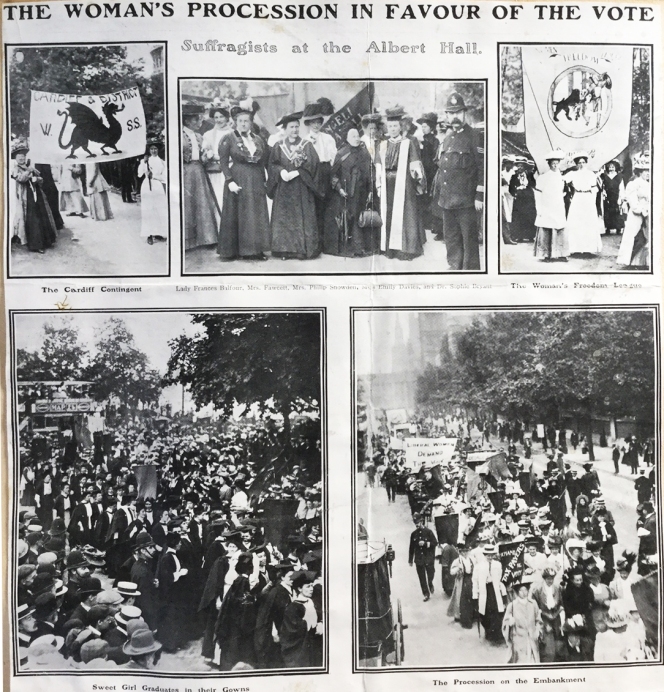
Taking tea in the 1920s, next to the tennis courts with Founders Building behind. [Image: Royal Holloway Archives]
We are delighted to welcome our guest student blogger, George Severs, who took time out from his final year studies to explore some little known sources in Royal Holloway’s Archives with some surprising results ….
Recently, I embarked on a minor research effort to find out whether or not Unity Mitford had visited Royal Holloway in 1937, knowing that she had been to Egham to drop her childhood nanny Laura Dicks (Blor to the Mitfords) off on holiday with her family. As I expected, there is no record of Unity Mitford or Blor in the Royal Holloway archive, but this search posed more questions than I had originally expected. Namely, how much do we know about interwar visitors to Royal Holloway College, and how do we know it?
There are two major sources which inform our knowledge of the College’s visitors during the interwar period: the Royal Holloway Visitors’ Book, and the Picture Gallery Visitors’ Book. Similar though they may sound, these two volumes are markedly different.
The Royal Holloway Visitors’ Book is a grandiose, lacquered tome, spanning the years 1887 to 1984 which holds the signatures of many members of the royal family and other esteemed visitors. Its interwar entries alone include the signatures of Queen Mary and Princess Helena Victoria both of whom visited in 1937, and the chairman of the London County Council who visited in 1939. Entries from these VIPs were often permitted an entire page for their entry.
The Picture Gallery Visitors’ Book, by contrast, is a worn ink-stained volume, full of entries. This book would have been accessible to the general public on days when the Picture Gallery was open to public visitors, which, during the interwar period, would have been Wednesdays and occasional Saturdays.
At first glance, then, we might assume that the Visitors’ Book was reserved for grand, often state occasions, whilst the Picture Gallery equivalent was available to the general public. Largely true though this is, closer consultation of both volumes yields a few unexpected entries.
Whilst entries of visitors to the Picture Gallery do overwhelmingly paint a picture of family outings and local visitors during the interwar period, there are a few remarkable exceptions. Tucked away just below one Hilda Price from Addlestone we find the signature of H. G. Wells, author of The War of the Worlds. Quite why he visited the Picture Gallery in August 1937, seemingly by himself, we do not know. What is interesting, however, is the lack of spectacle made of his visit, since Wells was well known internationally by 1937. Perhaps this points to the fact that the College’s managing parties were most, if not singularly concerned with titled and regal patrons, something which has gone largely unchanged.

Entry recording the visit of H. G. Wells. RHCAR/501/1. Image: George J. Severs
More surprising, and indicative of the College’s seeming lack of interest in non-royal visits, is an entry from May 26th 1938 which records the visit of a 500 strong delegation from the League of Nations, “about 100 of which signed this book”. As you may imagine, the College archivist and myself were quite astonished when I discovered this. Neither of us had any idea that this event had occurred, not least, perhaps, because it is quite literally squashed at the bottom of a page.

Entry recording the visit of the League of Nations delegation. RHCAR/501/1. Image: George J. Severs
The Visitors’ Book also contains entries which seem to go against the supposed grain of the volume. Ordinary, local people have their entries in the book, though a great deal less frequently. We do not yet know how, when and where this book was kept during public occasions, but it is safe to assume that it was infrequently available for the public to sign.
Both of these visitors’ books, then, tell us fairly extraordinary things about the people who visited the College between the wars. We know of the queens, princesses, and the politically powerful men who came, but what of the ‘ordinary’ women? Royal Holloway was, after all, a women’s college, and my search had originally been for a woman (though, admittedly, not an ordinary one).
A great many women visited Royal Holloway during the 1920s and 1930s, and the visitors’ books go some way in telling us about how women negotiated the College as a public space. Entries, particularly those in the Picture Gallery Visitors’ Book, suggest that women tended to visit the College in groups, whilst men like H.G. Wells, more often visited alone. Whether they were local, like Mrs Butler and Mrs Bauchamp (both from Egham, visiting on September 10th 1936), or foreign visitors, such as a group from Paris visiting in June 1937, female visitors overwhelmingly came in groups.
As sources, the books are of course imperfect. We know very little about when, where and how exactly they were used, and often even less about the signatories themselves, hence they remain overlooked by most people. Yet, as this blog post has suggested, they can also offer valuable insights into the ways in which women (and men) visited the College during the interwar period, as well as the range of better known guests.
If you know anyone who visited Royal Holloway and why they did so please do let us know.
George J. Severs is a finalist in the Department of History at Royal Holloway, University of London, and an Undergraduate Liaison Officer at the Bedford Centre for the History of Women.









